How do we see colour and tone?
A healthy human eye can disnguish up to 1 million colours! We
have billions of colour and tonal receptors at the back of our
eyes which respond to a small part of radiaon in the form of
wavelengths and parcles.
“It is my opinion that as painters the more we understand the
process of creang our art works, the be er the outcome.”
Light from the sun comes in the form of wavelength frequencies
and scattered light due to dust and water droplets. Blue light
scatters more than other colours, being shorter and more
energetic. Distant objects like mountains seem bluer because the eye is seeing
them through layers of scattered blue light which isoverpowering other colours.
Thus the sky is blue.When the sun is low at sunset and the light is travelling an extra
distance,
there is much more scattering of blue light, so the
red and orange longer wavelengths are more easily seen.
A rainbow occurs where visible light in the form of white radiation is refracted
through millions of water droplets into component colours and those colours get
sorted in order of wavelength. Violet and Blue have the shortest wavelength
and therefore highest energy and can bend more than longer wavelengths. Violet and blue
are
seen beneath the warmer, longer wavelength colours which bend less.
The Electro Magnetic Spectrum
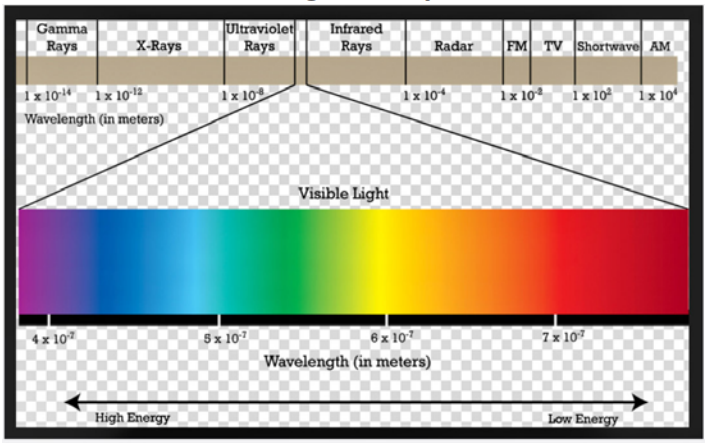
The diagram to the above shows energy from the sun, known as
the Electromagnec Spectrum. We see only a small part of this
radiation.
One end of the radiation spectrum is short, high energy such as
nuclear, x-ray and UV. Next is the small section of visible light.
Blue light is the shortest wavelength and therefore highest in
energy. The less energetic wavelengths include infrared and
radio waves.
We see an object as having a colour due to absorption and
reflection by the object at a molecular level. A green apple
absorbs all of the wavelength frequencies of visible light except
for the green wavelengths. A red apple absorbs most of the
green wavelengths and reflects the red.
Light and Shadow - Introducing Form and Cast shadows
There are two types of light: Direct(from the sun) and Ambient
(from reflected light, or known as Secondary light source).
This is very important to the artist since a shadow is the
recipient of many complicated effects due to the type of light
source.
|
Here the light is Direct creating the very white
shape of the snowy mountain. Note the ambient
light in the shadows collecting scattered blue
light from the sky. Note the shadow is tonally darker
than the sky.
|
See the shadows on this teacup spliting the cup in half with a
soft edge running vertically. This is the Form Shadow. Where the
cup is turned away from the light. Now look at the hard edge of the
Cast Shadow from the handle and the saucer, A cast shadow
falls on another object and its shape is dependant on
the angle of light. Whereas the Form Shadow is on the
object and is on the shaded side of that object. On a
rounded form a Form Shadow is soft along the
main edge.
Components of Form and Cast shadows
There are about 7 different components of a Form Shadow and 5
on a Cast Shadow.
FORM SHADOW
-
Bleached out colour (any colour) of the direct light called the
Highlight.
-
The Lit Area where the object has strong lighting on it but
colour is visible.
-
Halftone area, that blurred transition next to the Lit Area and
where the true colour resides. Here there is more intense
colour of the true overall colour of the object.
-
Core Shadow: a no man’s land as it were. Always a cooler and
darker slither of shadow helping the eye create a sphere or
rounded surface. It is trapped light between the Lit Area and
the Reflected Light Area.
-
Reflected Light beyond the Core Shadow and taking up
secondary ambient light from another adjacent object.
-
Crevice Shadow is where there is no light so is very dark.
CAST SHADOW
-
Umbra and penumbra.
-
Soft Edges further
away
-
Harder Edges nearer to
the object.
-
Terminator Shadow,
blur on the shadow
edge.
-
Reflected Light, contrary to some opinions cast shadows do
contain reflected light from the object casng the shadow
Reflected Light in the Shadows
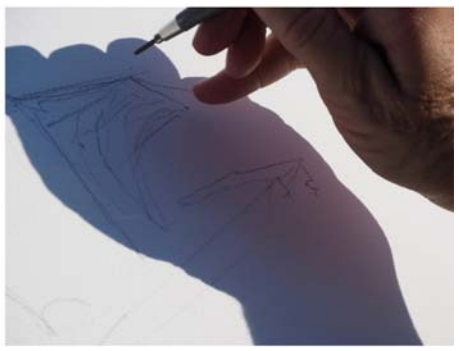
Here my hand
shadow is capturing
reflected light from
the sky and from my
hand. Overall, the
shadow is on the
blue side. A cast and
form shadow are full
of colour!
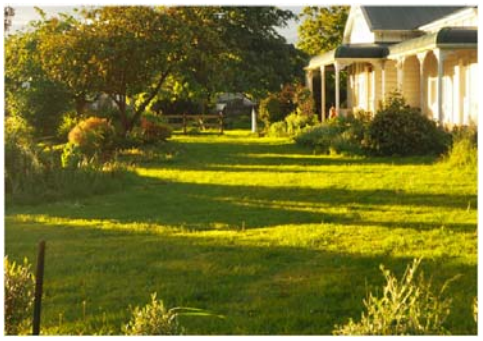
Observe how a
cast shadow is a
darker version of
what it is falling
over. You will also
take in the
scattered blue
light that is always
within an area of
shadow.
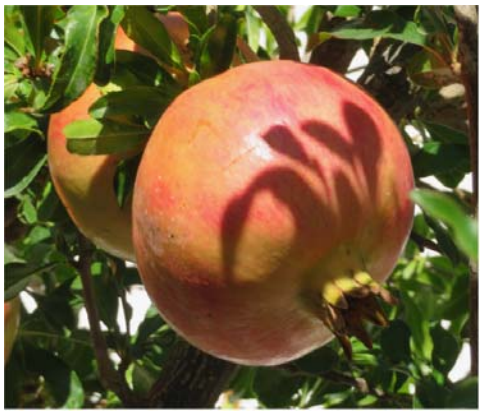
Observe how on
the cool grass the
shadow is dark
green and on the
pomegranate the
shadow is warmer
and more orange.
Both are still cool
containing plenty
of blue. Note the
blurry red edge
shadow
(Terminator
shadow).
|
This was an amazing photograph I took of a duck with an almost
complete visible spectrum of colours in order down its form
shadow! Under the duck’s neck is the influence of the blue sky,
then as the chest comes around there is the influence of the
grass and finally the yellow, orange and red influence of the legs.
|
Because of the predominance of scattered blue light, shaded areas contain more detectable
blue.
When painting push the blue.
But how do we see Colour? And what makes an object have a colour?
Back in the day, conducting research
into spectral analysis of soil types and
vegetation, I used an artist’s version of
analysing colour for soil and his name
was Albert Munsell. His “Colour
Notation” was used by many disciplines
of scientist and art. Little did I know I
would be coming across Albert Munsell
later in my art journey!
At the back of the eye reside millions of colour and tonal
receptors. Armed with their particular proteins, sensitive to
wavelengths and light. They sort a part of the Electromagnetic
Spectrum that allows our brain to make sense of form and space.
Tonal receptors are skinny and resemble rods and colour
receptors are cone shape. There are approximately 120 million
rod cells that do not pick up colours but allow us to see in low light.
Rod shaped cells allow us to see tonal variations in dim light and
colour receptors, which are cone shaped, dependant on strong
light and are sensive to colour.
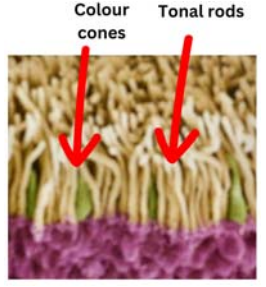
We have about 6 million cone
cells sensitive to long visible wavelengths (roughly translated
red), medium wavelengths/(green) and short, high energy
wavelengths/(blue). We see more variations in green because
our medium wavelength receptors are more numerous. Magenta
has no wavelength and is an exception and we mix signals for the
short and long wavelength cells (blue and red) to make it. Our
brain does quite a bit of alternave processing! To make sense of
a dull colour we mix tonal and colour receptors.
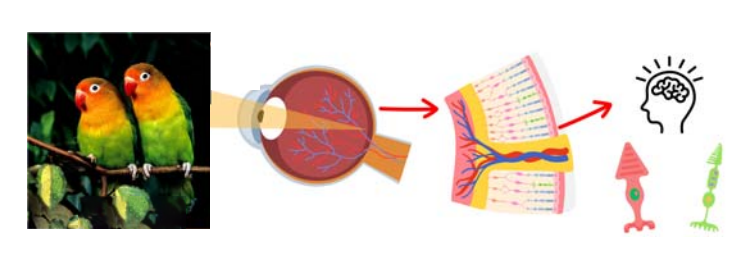
Munsell Color System
At the turn of last the
century, American
artist, Albert Munsell,
with the help of leading
scientists and artists,
developed a way of
understanding what
colour is, and developed
the Hue, Tone and
Chroma concept. He has
been a huge influence
in science and art.
As a general rule when
painting I stick to this:
Far - Near
Cool - Warm (hue)
Light - Dark (tone)
Dull - Bright (chroma)
Simultaneous Contrast, Colours are determined by what is adjacent
When complementary colours,
light - dark and
dull - intense
colours are next
to each other
we see one or
the other more
intensely.
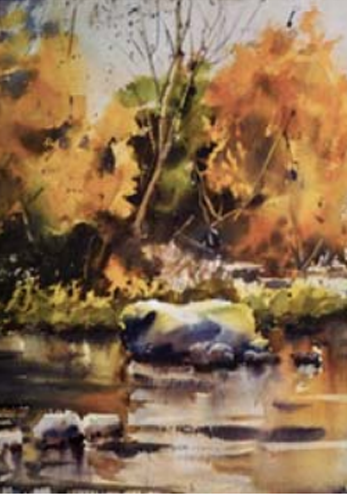
Dull against bright contrast
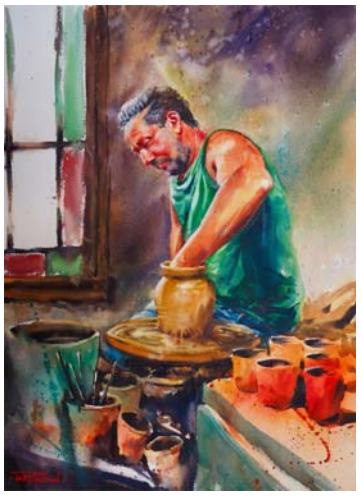
Complementary colours:
red and green
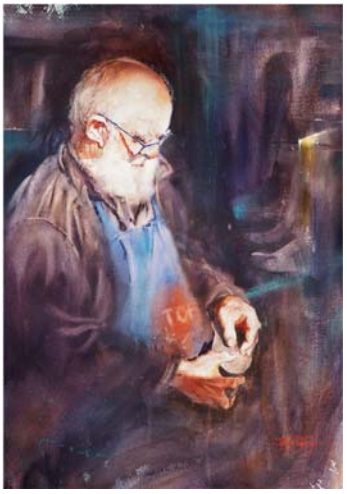
Light against dark contrast
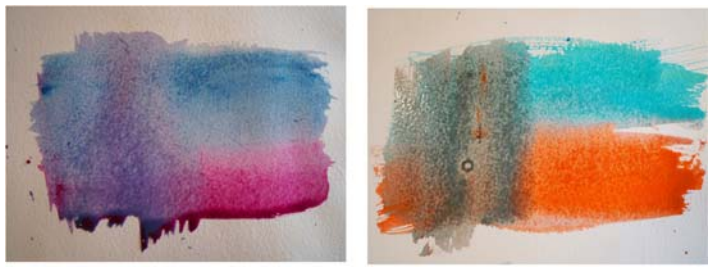
Alternavely you can use complementary colours in a mix
and
achieve beauful greys!
As much as possible, study the effects of natural light and
shadow from life, this is the best teacher!
|
Reflections are
mirror images that
are always duller
than the object
colour because light
bends and gets
distorted on the
surface which is
never quite a mirror.
A reflection is also
the opposite in tonal
value unless it is a
midtone when it is
the same tone.
|
It is interesting to note that if you have a cataract, a yellow
discolouration of the lens you will be filtering out the shorter blue and
greener wavelengths and seeing more of the longer yellow orange and
red wavelengths. Another interesting point is that since blue
wavelengths are shorter high energy and more abundant staring at our
computer screens is the equivalent of staring at the sky for hours which
is why too much screen time is quite harmful to our eye health!
Solution ... paint more!



